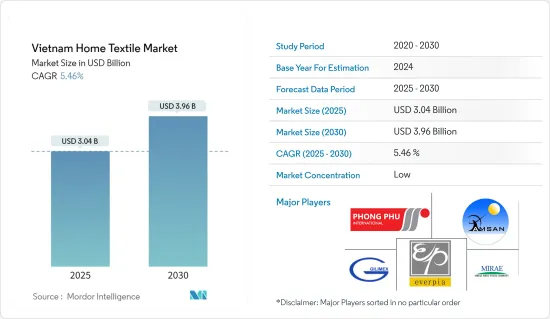PUBLISHER: Mordor Intelligence | PRODUCT CODE: 1630354

PUBLISHER: Mordor Intelligence | PRODUCT CODE: 1630354
Vietnam Home Textile - Market Share Analysis, Industry Trends & Statistics, Growth Forecasts (2025 - 2030)
The Vietnam Home Textile Market size is estimated at USD 3.04 billion in 2025, and is expected to reach USD 3.96 billion by 2030, at a CAGR of 5.46% during the forecast period (2025-2030).

In recent years, the Vietnamese home textile market has witnessed robust growth. This surge can be attributed to several factors, including a burgeoning middle-income group, rising disposable incomes, rapid urbanization, and evolving consumer preferences. Essential products in this market include bedding, bath linen, table linen, curtains, and upholstery fabrics. Both domestic consumption and export opportunities have fueled demand for these items.
Vietnamese manufacturers serve both local and global markets. The nation's textile and garment industries are robust, with numerous factories producing home textiles in tandem with apparel and other textile goods. While Vietnam competes with regional textile powerhouses like China, India, and Bangladesh, it distinguishes itself through a business-friendly environment, a skilled workforce, and strategic trade agreements that provide advantageous access to major export markets. Additionally, government initiatives to boost the textile industry and investments in advanced manufacturing technologies have further strengthened Vietnam's position in the global market.
Vietnam Home Textile Market Trends
Growth in Urbanization is Fueling the Market
In recent years, Vietnam has witnessed a notable trend toward urbanization as more individuals transition from rural to urban settings, driven by the pursuit of enhanced job prospects and living conditions. This trend has had a profound impact on various industries, including the home textile market. Urbanization has fueled the demand for home textiles in Vietnam for several reasons. As people move into urban areas, they often seek to furnish their new homes or apartments with comfortable and aesthetically pleasing items. This includes bedding, curtains, rugs, towels, and other home textile products. Urbanization has impacted people's transition from rural to urban living, with increasing adoption of a more modern and Westernized lifestyle, which includes a greater emphasis on home decor and interior design. This has created a growing market for home textiles that cater to these evolving tastes and preferences in Vietnam.
Growth in the Bed Linen Segment is Fueling the Market
As Vietnam's economy continues to develop, consumers are becoming more aware of and interested in home decor and improving their living spaces. Bed linen products, including sheets, pillowcases, duvet covers, and bedspreads, play a crucial role in enhancing the aesthetics and comfort of bedrooms. Additionally, the rise of the middle-income group in Vietnam has led to increased purchasing power and a greater willingness to invest in higher-quality bed linen products. The tourism industry also contributes to the growth of the bed linen segment. In recent years, Vietnam has emerged as a favored destination for tourists, drawing in a significant influx of international visitors. As the number of hotels, resorts, and homestays increases to accommodate the growing tourism demand, there is a parallel demand for high-quality bed linen to furnish these establishments.
Vietnam Home Textile Industry Overview
The Vietnamese home textile market is fragmented, with many players operating in the market. The report delves into the activities of key international players within this market. Notably, market dominance is currently enjoyed by a select few, namely Damsan Yarntex JSC, Everpia JSC, Gilimex, Phong Phu Corporation, and Mirae JSC. However, as technology evolves and companies innovate more with their products, the market is increasingly witnessing trends of mid-sized and smaller enterprises expanding their market footprint, clinching fresh contracts, and exploring novel markets.
Additional Benefits:
- The market estimate (ME) sheet in Excel format
- 3 months of analyst support
TABLE OF CONTENTS
1 INTRODUCTION
- 1.1 Study Assumptions and Market Definition
- 1.2 Scope of the Study
2 RESEARCH METHODOLOGY
3 EXECUTIVE SUMMARY
4 MARKET INSIGHTS AND DYNAMICS
- 4.1 Market Overview
- 4.2 Market Drivers
- 4.2.1 Fashion and Design Trends Driving the Market
- 4.3 Market Restraints
- 4.3.1 Increase in Raw Material Costs Restraining the Market
- 4.4 Market Opportunities
- 4.4.1 Customized Products Creating Market Opportunities
- 4.5 Industry Value Chain Analysis
- 4.6 Industry Attractiveness- Porter's Five Forces Analysis
- 4.6.1 Threat of New Entrants
- 4.6.2 Bargaining Power of Buyers
- 4.6.3 Bargaining Power of Suppliers
- 4.6.4 Threat of Substitutes
- 4.6.5 Intensity of Competitive Rivalry
- 4.7 Insights into Latest Technological Innovations
- 4.8 Insights into Government Regulations in the Industry
- 4.9 Impact of COVID-19 on the Market
5 MARKET SEGMENTATION
- 5.1 By Product
- 5.1.1 Bed Linen
- 5.1.2 Bath Linen
- 5.1.3 Kitchen Linen
- 5.1.4 Upholstery Covering
- 5.1.5 Floor Covering
- 5.2 By End User
- 5.2.1 Residential
- 5.2.2 Commercial
- 5.2.2.1 Hospitality and Leisure
- 5.2.2.2 Hospital
- 5.2.2.3 Offices
- 5.2.2.4 Other Commercial End Users
- 5.3 By Distribution
- 5.3.1 Supermarkets and Hypermarkets
- 5.3.2 Specialty Stores
- 5.3.3 Online Platforms
- 5.3.4 Other Distribution Channels
6 COMPETITIVE LANDSCAPE
- 6.1 Market Concentration Overview
- 6.2 Company Profiles
- 6.2.1 Damsan Yarntex JSC
- 6.2.2 Everpia JSC
- 6.2.3 Phong Phu Corporation
- 6.2.4 Gilimex
- 6.2.5 Mirae JSC
- 6.2.6 Metiseko
- 6.2.7 Viet Tra Co. Ltd
- 6.2.8 Hung Thanh Dat Company
- 6.2.9 Duc Hanh Garment JSC
- 6.2.10 Lotus Vietnam JSC*
7 MARKET FUTURE TRENDS
8 DISCLAIMER AND ABOUT US




